Mastering Lawn Mower Reading for Optimal Performance
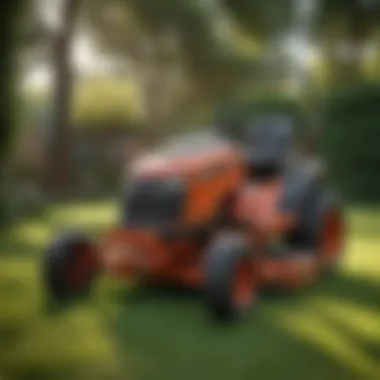
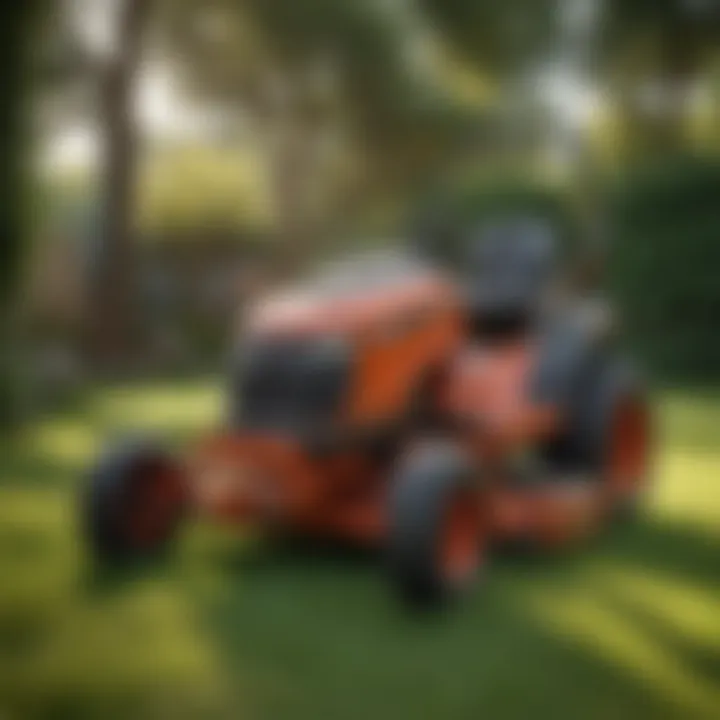
Overview of the Topic
Definition and Importance
Reading lawn mowers refers to the practices that allow users to understand and optimize the performance of these essential tools in lawn care. A significant part of landscape management, reading lawn mowers involves getting familiar with various features, maintenance requirements, and operational guidelines. Understanding these elements is vital for maximizing efficiency and ensuring that the mower operates at its full potential. Gardeners, farmers, and landscaping enthusiasts benefit greatly from mastering these practices, as they contribute to better lawn and crop health.
Current Trends
Recent developments in lawn care technology demonstrate a shift towards automation and smarter designs. Manufacturers are incorporating features such as GPS technology, advanced blade designs, and energy-efficient engines into their products. Furthermore, the rise of battery-operated mowers reflects a growing interest in sustainable practices. These trends not only improve the user experience but also promote environmental responsibility, making it essential for users to stay informed about advancements in lawn mower technology.
Key Techniques and Practices
Step-by-Step Guide
- Identify Your Lawn Type: Different grasses require different mowing heights. Understanding your lawn type is the first step.
- Familiarize with Your Mower: Read the owner’s manual. Know the settings and features available.
- Regular Maintenance: Change oil, sharpen blades, and replace filters according to the manufacturer’s guidelines.
- Set Proper Height: Adjust the mower height based on the grass species to promote healthy growth.
- Observe Performance Metrics: Monitor fuel efficiency and cutting quality to make necessary adjustments.
Tools and Equipment Needed
- Owner’s Manual: This is crucial for understanding your specific mower model.
- Tools for Maintenance: A wrench set, oil filter wrench, and blade sharpening equipment.
- Safety Gear: Gloves, goggles, and ear protection to ensure a safe operation.
Challenges and Solutions
Common Obstacles
While learning to read lawn mowers can enhance operational efficiency, several challenges may arise. One common issue is understanding the specific settings for different grass types. Additionally, many users find it difficult to keep up with routine maintenance schedules.
Innovative Solutions
Utilizing technology can alleviate many of these challenges. Here are a few solutions:
- Apps for Lawn Management: Several applications can help track maintenance schedules and provide tips based on grass type.
- Online Communities: Joining forums on platforms such as Reddit can offer insights and shared experiences from other users.
"Understanding your equipment is key to maintaining not just your mower but your entire lawn quality."
By delving into the practices of reading lawn mowers, individuals not only become proficient in managing their equipment but also contribute to a more sustainable approach in horticulture.
Foreword to Lawn Mowers
Lawn mowers play a crucial role in modern lawn care, serving not only as tools for cutting grass but also as essential equipment for maintaining the overall health and appearance of outdoor spaces. Understanding the intricacies involved in the operation and management of these machines can lead to significant improvements in efficiency and effectiveness. Consequently, this introduction sets the stage for a detailed exploration of various types of lawn mowers, their functionalities, and the history behind their evolution.
The significance of this topic extends beyond mere functionality. When one comprehends how lawn mowers work and their various designs, the benefits become evident. These insights can aid in selecting the right lawn mower based on individual needs, thereby optimizing performance. Furthermore, recognizing how lawn mowers have evolved over time sheds light on the innovations that have improved their design and efficiency.
Definition and Functionality
A lawn mower is defined primarily as a machine used for cutting grass. The basic functionality of a lawn mower involves employing a rotating blade or series of blades to cut the grass to a specified height. This height can be adjusted based on the type of grass and desired lawn appearance. Lawn mowers can be categorized into several classes, including rotary and reel mowers, each known for distinct functionalities suited for specific mowing conditions.
The operation of a lawn mower is not merely about cutting grass; it involves managing the lawn’s health, ensuring an even cut to promote healthier grass growth, and maintaining an aesthetic appeal. Many modern mowers incorporate advanced features such as adjustable cutting heights, mulching capabilities, and self-propulsion mechanisms, which enhance their efficiency.
Historical Evolution
The history of lawn mowers traces back to the mid-19th century, originating from the need for a more efficient means of cutting grass, which was traditionally done by hand. The initial designs were rudimentary, featuring iron blades that required substantial human effort. As the years progressed, technological advancements led to the creation of the first mechanical mower, tested by Edwin Beard Budding in 1830, which transformed how lawns were maintained.
The turn of the 20th century marked significant improvements in lawn mower design, particularly with the introduction of gas-powered engines. This development made mowing larger areas more feasible, leading to the commercial availability of lawn mowers. The evolution continued into the late 20th century, focusing on ergonomics and user-friendly features, such as lightweight frames and adjustable controls.
In recent years, the advent of electric and robotic mowers signified a dramatic shift towards sustainability and automation. These newer models not only reduce the environmental impact of lawn care but also address user convenience, allowing for more time spent enjoying well-kept lawns rather than laboring over them. Understanding this evolution provides context to current technologies and prepares users for emerging practices in lawn care.
Types of Lawn Mowers
Understanding the different types of lawn mowers is crucial for making informed purchasing and maintenance decisions. Each type of mower has unique features that affect its performance, usability, and suitability for various lawn care tasks. By recognizing these differences, agricultural professionals and enthusiasts can choose the right equipment that aligns with their specific lawn care needs. Moreover, being knowledgeable about the types of lawn mowers can play a significant role in optimizing mowing efficiency and achieving desired aesthetic results.
Rotary Lawn Mowers
Rotary lawn mowers are among the most widely used types. These machines utilize a horizontally-spinning blade that cuts grass efficiently as the mower moves forward. One major benefit is their ability to handle thick grass and weeds. Rotary mowers can be powered by gasoline engines or electric motors.
One of the greatest advantages of rotary mowers is their versatility. They can be use on uneven terrains and can handle different grass types. However, they may not cut as cleanly as other types, such as reel mowers, particularly if the blades are dull.
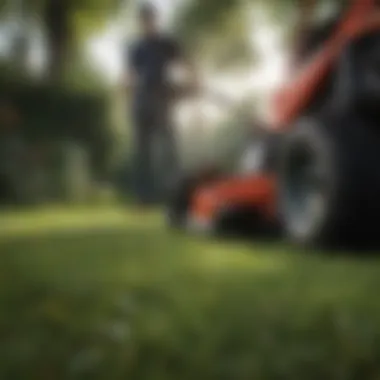
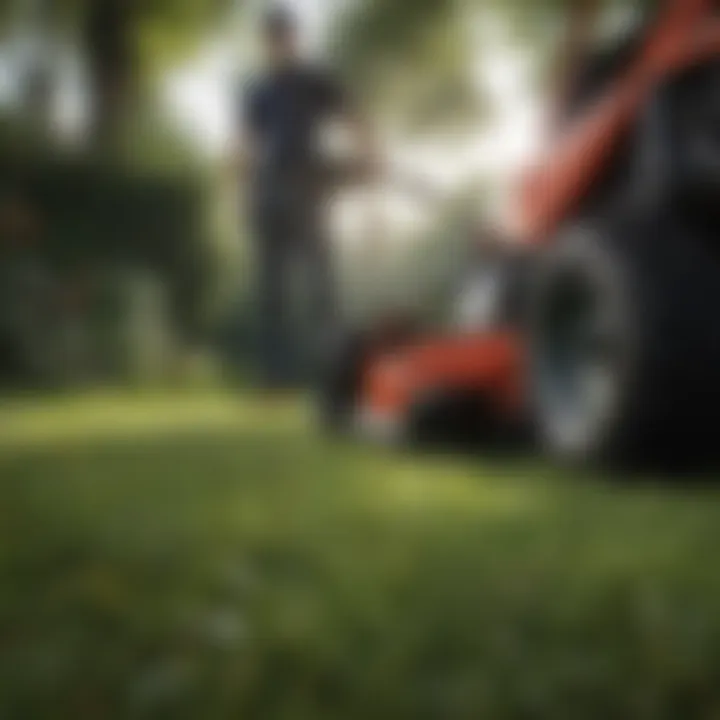
Reel Lawn Mowers
Reel lawn mowers are a more traditional option that operates with a series of blades that rotate vertically. This type of mower provides a clean cut, which some enthusiasts argue promotes healthier grass growth. They are typically lighter and easier to maneuver. They can be a good option for smaller lawns where precision is more important than speed.
Despite their benefits, reel mowers require more effort to push and may struggle with very thick grass. Regular maintenance is also essential to keep the blades sharp.
Self-Propelled Mowers
Self-propelled mowers represent a middle ground between manual and powered options. They have a driven mechanism that propels the mower forward, easing the physical strain on the user. The operator can control the speed and direction, making it a convenient choice for larger gardens or those with slopes.
These mowers generally come with both rotary and reel blade options, providing flexibility based on user needs.
Electric and Battery-Powered Mowers
Electric mowers, both corded and battery-powered, have seen a rise in popularity. They are quieter and produce no emissions, making them a more environmentally friendly choice. Battery-powered versions offer increased mobility without the hassle of cords, while corded models generally provide more consistent power for longer durations.
However, battery life can be a limitation for larger lawns. Electric mowers also have less cutting power compared to gasoline models.
Robotic Lawn Mowers
Robotic lawn mowers are the most advanced type in the market. These automated machines require minimal human intervention. They can be programmed to follow a schedule, mowing the lawn while the owner attends to other tasks. Robotic mowers come equipped with sensors to navigate obstacles and can handle smaller gardens efficiently.
Yet, they may be costly and typically not suited for larger or complex landscapes. Regular maintenance is necessary to ensure optimal performance.
In summary, understanding the types of lawn mowers available helps in selecting the right equipment for specific lawn care needs. Each mower type boasts its own set of advantages and disadvantages. Evaluating these aspects in relation to one’s lawn will enhance overall performance and satisfaction in maintaining a healthy and beautiful outdoor space.
Reading Lawn Mowers: Importance and Benefits
Understanding the importance of reading lawn mowers is essential for anyone deeply engaged in lawn care. This practice not only enhances the efficiency of equipment usage but also ensures optimal maintenance and longevity of the mowers. Knowledge in this area assists both amateur and professional users in making informed decisions about their mowing practices. The relevance of reading lawn mowers transcends simple operation; it encapsulates aspects of cost-effectiveness, aesthetic improvements, and overall care standards.
Efficiency in Lawn Care
Efficiency in lawn care is primarily defined by how well one operates equipment. Knowing your mower can lead to significant time savings and excellent results. Reading lawn mowers involves understanding their specifications, capabilities, and limitations. For instance, one must consider the cutting width when selecting the right mower for different areas of a lawn. A mower that is too wide may cause issues in narrower sections, while a smaller mower may require more passes, leading to inefficiency.
Also, operating a well-configured mower will yield a better finish when mowing. This reduces the time spent on touching up areas that require more attention. Moreover, it minimizes wear and tear on the machine, directly impacting its performance and lifespan. In practice, efficiency can be maximized by simply adhering to the manufacturer’s guidelines regarding speed, mowing patterns, and mowing frequency.
Cost-Effectiveness
Cost-effectiveness is another major consideration that arises from informed mower reading. Investing in a lawn mower is not just about the initial purchase but involves taking into account factors like fuel consumption, maintenance costs, and potential repairs. For example, a more fuel-efficient electric mower may have a higher upfront cost but can save money over the years with lower operating costs.
Additionally, understanding how to maintain a mower properly can lead to fewer repairs and prolonged equipment life. Regular inspections and maintenance activities are vital in preventing expensive problems before they escalate. This not only ensures that the mower remains reliable but also that the money spent on it yields the best return. Careful attention to performance metrics can directly contribute to lowering long-term financial burdens.
Enhanced Aesthetic Value
Lawn aesthetics significantly benefit from diligent mower reading and operation. When one selects the right mower for specific types of grass and terrain, it substantially improves the lawn's appearance. Proper mowing practices enhance the overall aesthetic value of gardens and lawns, making them healthy and vibrant while promoting growth.
A well-maintained mower ensures clean and precise cuts, which minimize damage to grass. This, in turn, leads to a lush and evenly cut lawn. Landscapers and homeowners alike understand the psychological impact of a well-kept lawn; it not only elevates personal satisfaction but also increases property value. \n
"Investing time in learning about lawn mowers can pay dividends in both the efficiency of lawn care and the beauty of the landscape."
In summation, grasping the importance of reading lawn mowers opens a pathway to more efficient, cost-effective, and visually appealing lawn care. The knowledge gained will ultimately enhance the user’s proficiency with mowers, improving the overall experience of lawn maintenance.
Key Metrics for Lawn Mower Performance
Understanding the key metrics for lawn mower performance is essential for both efficiency in lawn care and prolonging the lifespan of the equipment. Metrics such as cutting width, engine power, and blade quality provide insight into how well a mower can perform its task, impacting the overall results in maintaining a healthy lawn. Evaluating these factors helps lawn care practitioners make informed decisions when selecting or upgrading their equipment.
Cutting Width
Cutting width refers to the distance a mower can cut in a single pass. This metric directly influences the efficiency of lawn care operations. Mowers with wider cutting widths can cover more area in less time, which is particularly beneficial for larger lawns or agricultural applications. The ideal cutting width depends on the specific requirements of the user and the layout of the lawn.
Some key considerations include:
- Size of the Lawn: For extensive lawns, wider cutting widths are advantageous. However, for smaller or intricately shaped areas, narrower widths provide better maneuverability.
- Terrain: Uneven or hilly terrains may require more narrow cutting widths to prevent scalping or damage to the lawn.
- Types of Grass: Different grass types may react uniquely to various cutting widths. The goal should be to choose a width that promotes healthy growth without stressing the grass.
Power and Engine Types
The power and engine type of a lawn mower fundamentally affect its performance. Engine specifications determine how efficiently a mower can function under various conditions. The choice between gas and electric engines, as well as factors like horsepower, can significantly impact mowing tasks.
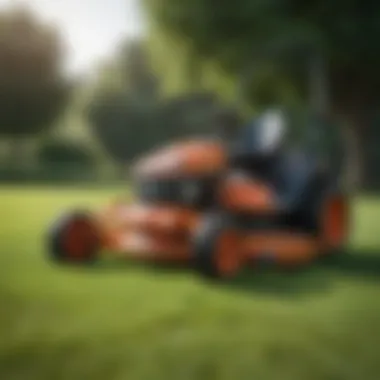
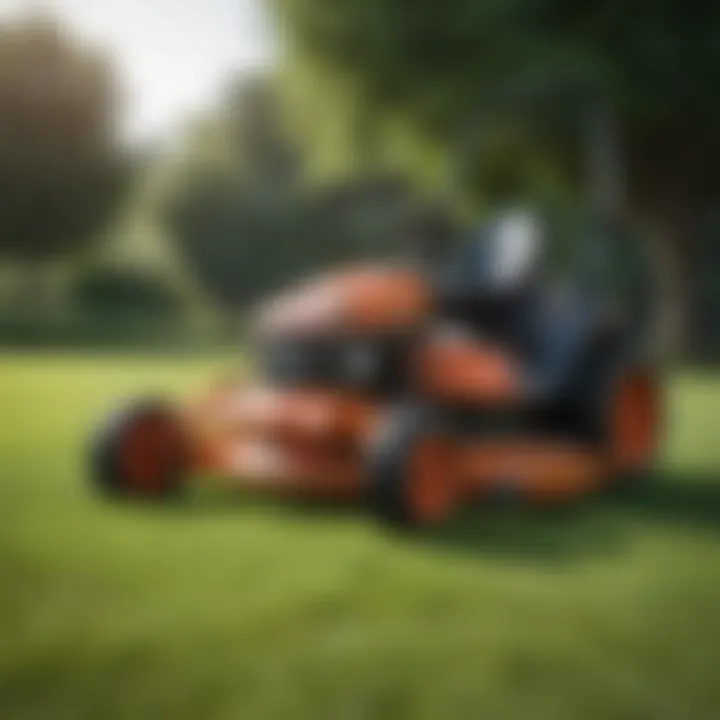
Some aspects to consider include:
- Gas Engines: Generally more powerful than electric counterparts. They are ideal for larger properties or more challenging terrains. However, they may come with increased maintenance and emissions concerns.
- Electric Engines: With advancements in battery technology, electric motors have become viable for many users. They are quieter, require less maintenance, and have a reduced environmental impact but may run out of power during extensive tasks.
- Horsepower vs. Torque: Higher horsepower means a mower can handle thicker grass and tough conditions. Torque affects how well the mower can maintain power when faced with resistance, like tall grass.
Blade Type and Quality
The type and quality of blades on a lawn mower play a crucial role in cutting performance. Blades must be sharp and designed specifically for the desired mowing results to ensure efficient operation.
Important considerations include:
- Material: High-grade steel offers durability and resistance to wear. Stainless steel can prevent rust and corrosion, prolonging blade lifespan.
- Design: Mulching blades are designed to cut grass into smaller pieces, returning nutrients to the lawn. Standard blades offer a cleaner cut but may not provide the same benefits to grass health.
- Regular Maintenance: Maintaining blades is critical. Dull blades tear grass instead of cutting it cleanly, leading to potential lawn health issues. Regular sharpening and replacements should be part of a lawn mower's maintenance routine.
"An efficient lawn mower not only enhances the aesthetics of your lawn but also contributes to its long-term health."
Ensuring that these key metrics are understood and regularly evaluated helps in making informed purchases and maintenance decisions. This understanding ultimately impacts the quality of lawn care, making it both efficient and effective.
Lawn Mower Maintenance Practices
Lawn mower maintenance practices are integral to ensuring the longevity and performance of mowing equipment. Regular upkeep not only enhances efficiency but also prevents significant repairs that may lead to increased costs. Understanding these practices is vital for farmers and lawn care enthusiasts alike. Focusing on specific elements of maintenance helps in achieving optimal results.
Regular Inspection Protocols
Conducting regular inspections is essential for maintaining the health of a lawn mower. During inspections, operators should check key components such as the engine, belts, and wheels. Noticing small issues before they escalate can save time and resources. Here are a few factors to consider during inspections:
- Engine performance: Listen for unusual sounds and monitor how the engine starts and runs.
- Fuel system: Look for leaks or discoloration in fuel lines.
- Belts and cables: Check for wear or fraying that can impede function.
- Wheels and tires: Ensure they are properly inflated and show no significant damage.
Implementing a routine schedule for these inspections ensures your mower operates smoothly and effectively.
Sharpening and Replacing Blades
One of the most critical aspects of lawn mower maintenance is ensuring blades are sharp. Dull blades can tear grass rather than cut it, leading to a stressed lawn. A quarterly sharpening schedule is recommended, although frequency may vary based on usage.
When sharpening or replacing blades, consider the following steps:
- Safety first: Disconnect the spark plug to avoid accidental starts.
- Blade removal: Use appropriate tools to safely detach blades from the mower.
- Sharpening: Employ a suitable sharpening tool, maintaining the original angle of the blade edge.
- Replacement: If blades are too worn, replace them with new ones to restore cutting quality.
Regularly maintaining blade condition results in a healthier lawn and prolongs the mower's lifespan.
Cleaning Procedures
Proper cleaning of a lawn mower can prevent grass buildup that may affect performance. After each use, it’s advisable to clean the cutting deck, as this area can accumulate clippings and debris.
Here are some cleaning tips:
- Use a scraper: Remove clippings stuck to the deck with a plastic or wooden scraper.
- Hose down the mower: Rinse off debris with water, but avoid soaking electrical components.
- Dry thoroughly: Ensure that the mower is dry before storing it to prevent rust.
Cleaning your mower promptly after use keeps it in top-working condition and reduces maintenance frequency.
Seasonal Care Recommendations
Seasonal care is critical for preparing a mower for both the spring and winter months. In spring, ensure that your mower is ready for the mowing season. This includes inspection, changing oil, and installing fresh spark plugs.
In winter, proper storage minimizes damage from cold weather conditions. Here are some seasonal strategies:
- Before winter: Drain fuel or add a stabilizer to prevent engine gumming.
- Store indoors: Keep it in a dry, sheltered location away from harsh weather.
- Cover the mower: Use a breathable cover to protect it from dust and moisture.
By following these seasonal care practices, you ensure your mower is ready for use when the growing season resumes.
Regular maintenance not only extends the life of your lawn mower but also enhances the quality of your lawn. Investing time in upkeep yields significant benefits in efficiency and aesthetic appeal.
Emerging Technologies in Lawn Mowing
Emerging technologies in lawn mowing represent a significant advancement in how lawn care is approached today. The integration of modern technologies allows for not only enhanced efficiency but also greater precision in lawn maintenance. As more agricultural professionals and enthusiasts recognize the impact of these innovations, the importance of staying informed about them cannot be overstated. This section delves into the specific elements of emerging technologies and outlines the benefits they bring to the field of lawn care.
Smart Mowing Solutions
Smart mowing solutions revolutionize the way lawn mowers operate. These technologies utilize sensors, GPS, and robotics to perform mowing tasks with minimal human intervention. For instance, robotic lawn mowers, such as the ones offered by companies like Husqvarna and Worx, navigate the yard autonomously. They can create efficient mowing patterns and adjust to varying terrain conditions.
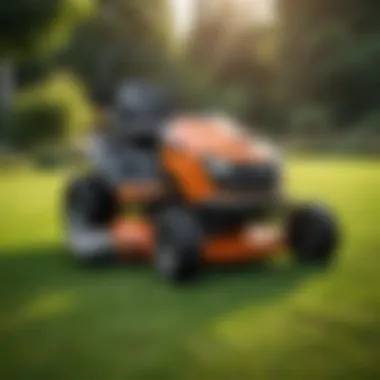
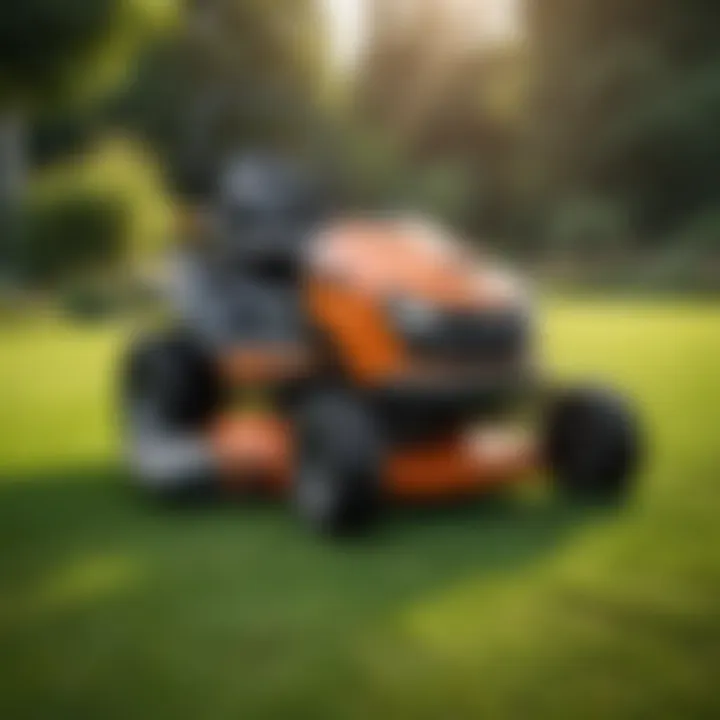
The significance of smart mowing solutions lies in their ability to save time and labor costs. They can operate at scheduled times without requiring constant oversight. Moreover, many models now integrate weather sensors, allowing them to adjust operation based on real-time weather conditions. This smart technology not only contributes to a well-manicured lawn but also promotes better resource management, reducing waste and optimizing energy use.
Data Analytics for Performance Monitoring
Data analytics is another crucial aspect of emerging technologies in lawn mowing. By collecting and analyzing data from mowers, operators can gain significant insights into their performance. This information includes cutting patterns, blade wear, and overall efficiency. Companies are beginning to embed sensors within mowers that track these metrics, providing valuable data to users.
Such data monitoring systems offer a range of benefits. It enables operators to identify patterns that indicate when maintenance is needed, potentially prolonging the life of the equipment. More importantly, data analytics allows for continuous improvement in mowing performance. \n Implementing these advanced monitoring solutions can lead to significant cost savings. For example, operators can optimize mowing schedules and energy use based on the data received. As a result, the emphasis shifts from reactive maintenance to proactive management, fostering a more sustainable approach to lawn care.
"With the rise of smart mowing solutions and data analytics, minds in lawn care are turning to efficiency and sustainability as primary considerations."
In summary, emerging technologies in lawn mowing not only transform operational efficiencies but emphasize a future-oriented approach to lawn care. Understanding and adapting these innovations is essential for anyone serious about maximizing effectiveness and sustainability in their lawn maintenance practices.
Environmental Impact of Lawn Mowing
Understanding the environmental impact of lawn mowing is crucial in today's context of sustainability. This section highlights the implications of mowing practices on the ecosystem and delves into both the negative and positive aspects. Efficient management of lawn mowing can reduce harmful effects, promoting ecological balance.
Carbon Footprint Considerations
When lawn mowers operate, they often contribute to greenhouse gas emissions. Traditional gas-powered mowers emit carbon dioxide and other pollutants. The Environmental Protection Agency states that a gas lawn mower can produce as much air pollution in one hour as driving a recent model car for over 1,200 miles. This highlights the need for alternative options.
Electric mowers, both corded and battery-powered, are significantly friendlier to the environment. They produce no tailpipe emissions and run quieter. Choosing these types of mowers can lead to a lower individual carbon footprint. Furthermore, individuals can consider the following:
- Choosing Energy-Efficient Models: Look for mowers with eco-friendly certifications.
- Regular Maintenance: Keeping mowers in good condition ensures they run efficiently, minimizing emissions.
- Optimal Fuel Use: For gas mowers, using the recommended fuel can reduce the carbon output.
"Selecting a mower with a lower carbon impact not only conserves energy but aids in reducing the collective environmental footprint."
Sustainable Practices
Adopting sustainable practices in lawn mowing is not just a trend but a necessary step forward for responsible lawn care. Some practices enhance the ecological footprint while maintaining a lush lawn. Here are ways to contribute:
- Mulching Mowers: These mowers cut grass into fine pieces, allowing them to decay and return nutrients to the soil. This provides a natural fertilizer.
- Reducing Lawn Size: Opting for smaller grass areas or incorporating flora that requires less maintenance can limit the need for frequent mowing.
- Opting for Natural Landscapes: Consider native plants that thrive in the local environment and require minimal watering and mowing.
- Proper Timing of Mowing: Mowing during cooler times of the day helps minimize fuel use and stress on the equipment, leading to longer-lasting operations.
Sustainable lawn care benefits both the environment and the aesthetics of the property. By choosing eco-friendly alternatives and practices, individuals contribute to a healthier world and improve the sustainability of their gardening activities.
Future Trends in Lawn Care Equipment
As technology rapidly evolves, the lawn care industry is not left behind. This section explores important developments which will shape the future of lawn care equipment. Staying updated on these trends ensures that agricultural professionals and enthusiasts can optimize their operations while embracing sustainable practices.
Integration of AI and Machine Learning
The incorporation of artificial intelligence and machine learning into lawn care equipment offers substantial benefits. These technologies allow lawn mowers to adapt to varying conditions by analyzing data from their environments. For instance, AI can help lawn mowers navigate obstacles and optimize their cutting paths, increasing efficiency and safety.
Some key advantages include:
- Improved Precision: AI algorithms can help maintain a uniform grass height throughout the lawn.
- Data Collection: Machine learning can assist in tracking usage patterns. This data can lead to enhanced performance and decision-making based on actual needs.
- Customization: Operators can create mowing schedules tailored to specific lawn conditions, reducing wear on equipment.
Implementing AI in lawn care does not only improve performance but also encourages sustainable equipment practices.
Impact of Renewable Energy Sources
Renewable energy sources are becoming more vital in lawn care equipment, reflecting a shift toward sustainability. Traditional gas-powered mowers contribute to pollution and greenhouse gas emissions. In contrast, models powered by renewable energy sources reduce these negative impacts.
Key aspects to consider include:
- Solar-Powered Mowers: Some manufacturers are producing solar-powered mowers that operate efficiently while minimizing energy consumption.
- Battery Technology Advancements: The development of high-capacity batteries allows for longer and more reliable operation, enabling longer mowing sessions without frequent charging.
- Emission Reduction: Transitioning to electric or hybrid mowers significantly lowers carbon footprints compared to their traditional counterparts.
Shifts toward renewable energy provide both environmental and economic benefits, promoting responsible lawn care practices.
The future of lawn care equipment hinges on embracing innovation while prioritizing sustainability.
End and Recommendations
In the realm of lawn care, the ability to effectively read and understand lawn mowers plays a pivotal role in enhancing efficiency and longevity of the equipment. This article elucidates the intricacies of lawn mower operations, shedding light on the various types, performance metrics, and maintenance practices that are integral to optimal lawn management. The recommendations outlined here will assist users—from agriculture professionals to enthusiasts—in maximizing their mowing strategies and ensuring the sustainability of their practices.
Summary of Key Points
- Understanding Different Types of Mowers: Familiarity with rotary, reel, and robotic lawn mowers can significantly affect decisions made by users based on their lawn requirements. Each type has unique advantages, with specific features catering to varied terrains and mowing preferences.
- Importance of Regular Maintenance: Maintenance practices, such as blade sharpening and seasonal cleaning, are necessary to keep lawn mowers in peak condition. Failure to adhere to maintenance schedules can lead to decline in performance and an increase in operational costs.
- Performance Metrics: Knowing how to judge a mower's cutting width, power specifications, and blade quality can guide consumers in selecting the right equipment tailored to their lawn care needs.
- Technology Integration: The emergence of smart mowing solutions and data analytics positions users to harness advanced techniques to enhance lawn care efficiency. Adopting these technologies fosters not only effective mowing practices but also contributes to environmental sustainability.
Future Considerations for Lawn Care
As we look forward, advancements in lawn care technology will further shape how we approach mowing. Key considerations include:
- Integration of AI in Lawn Mowers: The incorporation of AI can lead to improved operational efficiencies. Intelligent mowers can evaluate the best mowing patterns, adapting to changing environmental conditions seamlessly.
- Focus on Renewable Energy Sources: The shift towards greener energy solutions in lawn mowers will likely gain traction. Solar-powered options, for instance, can reduce dependency on fossil fuels, minimizing carbon footprints associated with lawn care.
- Emphasis on Sustainable Practices: Moving forward, sustainability will be a core focus area. Practices that reduce chemical usage and promote biodiversity will benefit not just the environment, but also enhance the overall health of the lawns.



